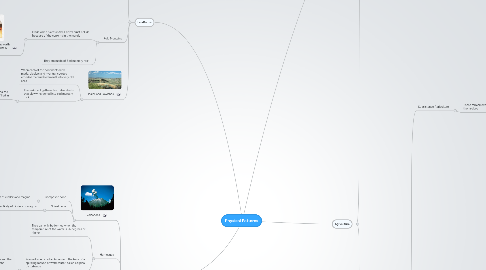
1. Natural Disasters
1.1. Volcanoes
1.1.1. Composite cone
1.1.1.1. Made of layers of cinders and magma
1.1.2. Shield cone
1.1.2.1. Made entirely of cinders or magma
1.2. Hurricanes
1.2.1. They can only be formed when the temperature of the water is 26 degrees or higher
1.2.2. Formed when cool air blows into the base of a spiraling mound of warm water, called a trpical disturbance
1.2.2.1. The new air gets heated and rises and the tropial disturbance grows larger and faster,making it a hurricane
1.2.2.1.1. The Saffir-Simpson sccale is used to measure the wind speed, severity, and height of thhe storm surge
1.3. Tornadoes
1.3.1. Warm air rises and cold air rushes down
1.3.1.1. Warm air starts to spiral around the cold air,forming a vorex
1.3.1.1.1. Doppler radars ar used to warn people if there is the danger of a tornado
1.3.1.1.2. Can reach speeds of about 6o km/h or less
1.4. Tsunamis
1.4.1. Caused by underwater earthquake
1.4.1.1. When two tectonic plates collide underwater it cause waves to spread out in a circle
1.4.1.1.1. Waves get bigger and faster the farther they go
1.4.2. Name comes from Japenese word for harbor wave
2. Landforms
2.1. Ancient Sheilds
2.1.1. Created by lots of volcanic activity that happened a long, long time ago
2.1.2. It was made of igneous rock (Solid Magma)
2.1.2.1. Heat and pressure over a long time made it into metamorphic rock(changed rock)
2.1.2.1.1. It slowly broke apart and the sheild regions are present all over the world
2.2. Fold Moutains
2.2.1. Made when plates in the Earth's crust collide because of the currents in the mantle
2.2.1.1. When the plates keep colliding the earth above starts wrinkling into a mountain shape
2.2.1.1.1. Over a long period of time the mountain gets bigger and bigger
2.2.1.1.2. Can divide the flow of rivers and form new ecozones
2.2.2. They are made of Sedimentary rock
2.3. Plains and Lowlands
2.3.1. When each of the continents were made, glaciers and river transported erodded material(sediment) into very old seas.
2.3.2. The sediment gathered into deep beds that slowly hardened into sedimentary rock.
2.3.2.1. New land was created around the ancient sheilds as the seas filled in.
3. Climate
3.1. Factors that cause different climates are the sun, moving air like wind, bodies of water, mountains, and ocean currents
3.1.1. Polar climate
3.1.1.1. Generally in the north and south pole
3.1.1.2. Suns rays get widely scattered when they are close to the poled because the rays hit at an angle
3.1.1.3. Severe winters and cold summers
3.1.2. Tropical climate
3.1.2.1. Around or on the equater
3.1.2.2. There is solar rdiation all year so it is very hot
3.1.2.3. Hot all year and lots of moisture
3.1.3. Temperate climate
3.1.3.1. Between south pole and equater
3.1.3.2. Sun's rays hit at a slight angle
3.1.3.3. Temperature is moderate all year
3.1.4. Desert climate
3.1.4.1. Near the equator
3.1.4.2. At the equater there is lots of rain, then the air moves north and south. The air cools then sinksto the equater. The sinking air is very dry.
3.1.4.3. Very dry and there is rarely precipitaion
3.1.5. Maritime Climate
3.1.5.1. Near large bodies of water
3.1.5.2. There is lots of precipitaion when the wind blows
3.1.5.3. Cold winters, warm summers
3.1.6. Continental Climate
3.1.6.1. All over the world
3.1.6.2. Not near large bodies of water
3.1.6.3. Hot summers, cold winters, and dryer than maritime climate
3.1.7. Mountain Climate
3.1.7.1. Where mountains are
3.1.7.2. Main characteristics change with altitude
4. Agriculture
4.1. Effects of the Earth
4.1.1. Climate
4.1.1.1. The main factor that makes soil
4.1.1.2. Water, wind, and ice make the eroded sediments that create soil
4.1.1.3. In order for animals and plants to grow properly, the climate has to be just right for them
4.1.2. Soil
4.1.2.1. Soils have different layers from the top to the bottom
4.1.2.2. A soil profile is the parallel bands of colour that becomes lighter brown the deeper the soil is
4.1.2.3. If the soil is dark and thick in the upper layers of the soil, it has great soil fertility
4.1.3. Natural vegetation
4.1.3.1. Natural vegetation is important for soil fertility because the decomposing leaves, grasses, and needles make the first layer of soil
4.1.3.2. Broad leaf forests and Grasslands produce organic material, making the soil fertile
4.1.3.3. Coniferous trees don't make a lot of organic material becaise their needles are acidic, which makes the soil have limited fertility
4.1.3.4. Heavy rain washes most of the nutrients in tropical rainforests deep down into the ground so it is not really good for anything except shifting cultivation(a form of temperary farming)
4.2. Different types of Agriculture
4.2.1. Subsistence Agriculture
4.2.1.1. These farmers work full time to feed themselves
4.2.1.1.1. Nomadic Herders
4.2.1.1.2. Shifting cultivators
4.2.1.1.3. Small Landholders
4.2.2. Commercial Agriculture
4.2.2.1. Produces large amount of one or a few crops, livestock, or other farm product and sells it fo money
4.2.2.1.1. Raw Materals
4.2.2.1.2. Transportaion
4.2.2.1.3. Market Forces
4.2.3. Specialized Agriculture
4.2.3.1. Commercial farming only focused on a single product
4.2.3.1.1. Orange Groves: Climate amd Market
4.2.3.1.2. Nursuries: Location and Raw Materials
4.2.3.1.3. Coffee: Location and Labour
